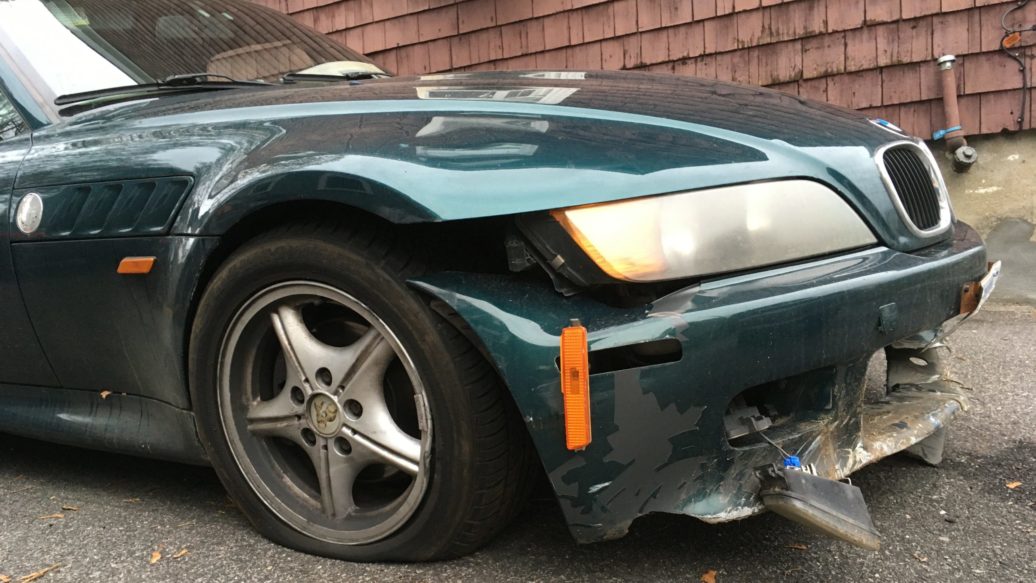I’ve written many times about the slightly ratty Boston Green 1999 Z3 2.3 that I bought eight years ago for the then-unheard-of-cheap price of $3,000. I called it Zelda the Therapy Car because dropping the top was the equivalent of rolling Xanax; I loaned it frequently to my wife’s and my female friends (aka the Cult of Zelda), and then sold it to one of them (Kim) two years ago when I ran out of garage space. Since Kim lives behind us (we talk over the fence, but it’s three left turns if I have to drive there), I’ve remained the car’s stepfather, or uncle, or sugar daddy, or something, and have continued to repair it for her.
Whenever I drive it, I’m reminded how much I like Z3s and their snappy handling, and how much of a soft spot I have for this particular unassuming little Z3. I even continue to be in touch via Facebook with the woman from whom I bought the car, who is thrilled to read about how the Z3 continues to have such an effect on people.
At the end of August, while doing another round of work on Zelda for Kim, I found that the car needed a clutch; it was chattering on release, and the throw-out bearing was getting really loud. My advice to her was to enjoy the car through the fall, but I said that after that, she’d need to face the music. I warned her that a clutch replacement fell outside of what I could do, either as a favor or a charged repair. I have a mid-rise lift in my garage, but since the body of the lift is in the way of the transmission, it’s non-trivial to pull the transmission with the car on the lift. Plus, even though it’s been seven years since I did the clutch in my Z3 M coupe, I still wince when I remember how much of a pain in the butt it was reaching those Torx-head fasteners on the upper part of the bell housing, and snapping off four of the six studs holding the headpipes to the exhaust manifolds.

In October, Kim said that she thought the time had come to let go of Zelda, and with all the work I’d done on the car for free, I should have first rights if I wanted to buy her back. On the one hand, this was incredibly appealing; those of us who buy cars know that any “in” you have on a car that isn’t advertised anywhere is a precious and valuable thing. But for several reasons, I vacillated. The first is that space in my garage is even more precious than that “in,” and if I was going to take on an over-winter project, I thought that it should be something new for me, maybe something American or Japanese to widen my horizons—not a clutch on a car I’d already owned and sold.
But the second reason was that work we do for dear friends for free is a funny thing. Kim didn’t owe me anything; it’s not as if I reattached Zelta’s accelerator pedal and replaced the mirrors in August with the expectation that I was doing it in order to put credit in a buy-back-Zelda-at-a-discount account. When I bought the eight years ago, I have zero doubt that at $3,000 it was the least-expensive, running, non-wrecked six-cylinder Z3 in the country, but now that’s no longer an unheard-of price. I see needy but running M52 Z3s in the low-$2,000 range every month on Craigslist and Facebook Marketplace, although they sell quickly.
So, with the car needing a clutch, what was it worth to me?
I thought about it and kept coming up with $1,500. Had I offered that price, Kim probably would’ve accepted—and that was the problem. I figured that if she advertised the car, even candidly admitting that it needed a clutch, she could probably sell it in a heartbeat for $2,300, so it wouldn’t be fair of me to make her an offer that she’d accept that would deprive her of roughly $800.
With all these considerations, I was hesitant to commit the only available over-winter space in the garage to Zelda, and essentially treated the car like a benefit-friend I’d only ask to the prom if all the girls I really liked turned me down.

But then, three days ago, I got a call from Kim’s son Tyler. Zelda had been crashed. He’d just finished working a seventeen-hour day, pulled out of a parking lot, swerved to avoid someone, and ran into a median strip. The car’s nose was splintered, the airbag had deployed, and two of the tires were flat. He’d managed to limp the car back into the parking lot.
Kim was heartbroken. Tyler felt awful. I felt that if I’d just made a decision and bought the car back, none of this would’ve happened.
I spoke with both Kim and Tyler about what to do about the car. I initially recommended that they just call the insurance company and have them deal with it where it sat, but there is some value in getting a car home; then you have control over it, and if you decide to deal with it yourself, you aren’t assessed impound or storage fees.
Kim said that she had free tows left on her AAA account. We agreed that if she towed the car back to Newton, I would look at it and advise her. I’m not a body expert, but I prepared her for the outcome that, from the description of a front-end impact strong enough to set the airbag off, it was likely that the insurance company would total the car, that it wouldn’t be easily repairable, and that this would be the end of the line for Zelda. Kim went to meet the tow truck, and texted me photos of the car.
And… it didn’t look as bad as I expected.
The right front wheel was clearly pushed back, and the air dam was splintered and hanging, but I wasn’t seeing a horror of hood-up, bashed-in-the-face, angular, crumpled sheet metal.
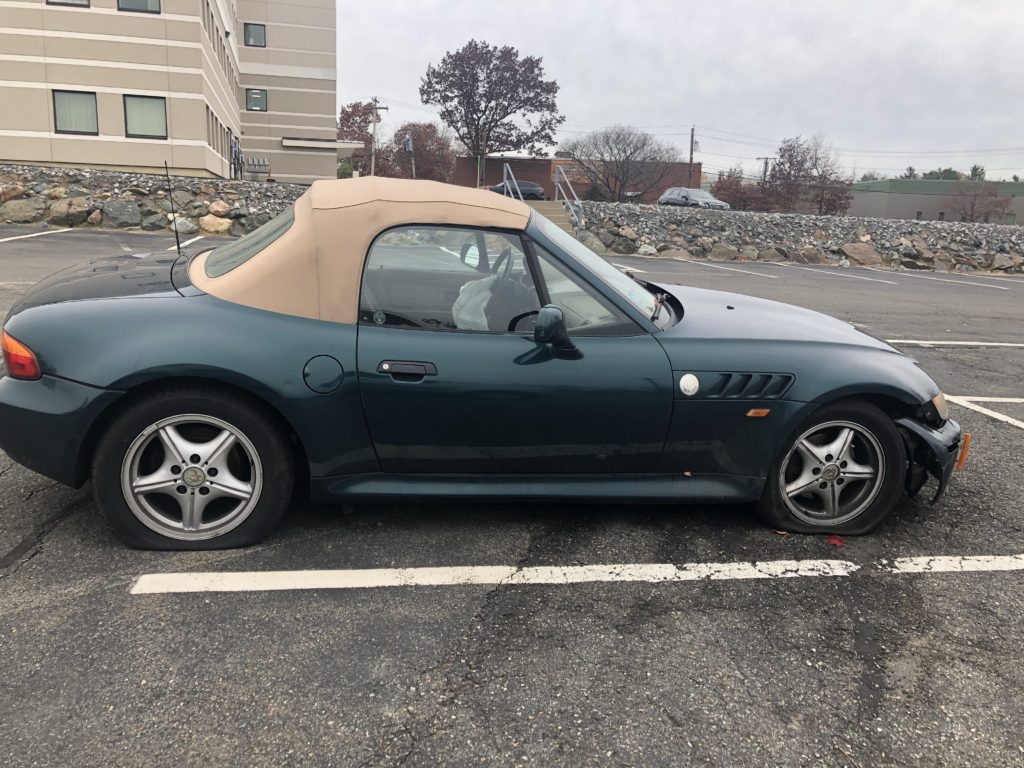
Poor Zelda.
Tyler called me a few hours later and said that the tow truck had dropped the car off in their driveway. I rooted around under my back porch, looking for some wheels and tires to throw on the car and replace the bent and flat ones, then remembered that I’d sold nearly everything in a clean-out binge over the summer, and saw that the only five-lug wheels I had were the original steelies from the Bavaria, wearing tires that were likely 30 years old. I verified that the Bavaria wheels had a 72.5-mm center bore like the Z3’s wheels, rolled them to the garage, inflated them with the compressor, verified that they held air, and threw the wheels, a jack, jack stands, and a breaker bar in the trunk of the E39, and drove the three left turns over to Kim’s.
I had a visceral gut-punch reaction when I came face-to-face with Zelda, but as I looked at the car, I realized that the splintered air dam, hanging lights, and pushed-back right wheel notwithstanding, I didn’t see any bent or crumpled sheet metal. I chatted briefly with Tyler, who said that he probably hit the curb while going about twenty mph, right front wheel first, and then all four wheels went onto the median strip.

Ouch, but maybe not a fatal ouch.
It was difficult for me to judge things with the car sitting on two flat right-side tires, so I jacked up the right front and tried to put one of the Bavaria wheels on. I wasn’t really surprised when I found that it wouldn’t clear the front brake caliper. I looked through the rear wheel at the rear caliper, saw that it was much smaller than the front caliper, tried the Bavaria wheel there, and found that it fit. I then rearranged the wheels so the Bavaria steelies were on the back, and the two fully-inflated Z3 wheels were on the front. The car suddenly looked awake and alert.
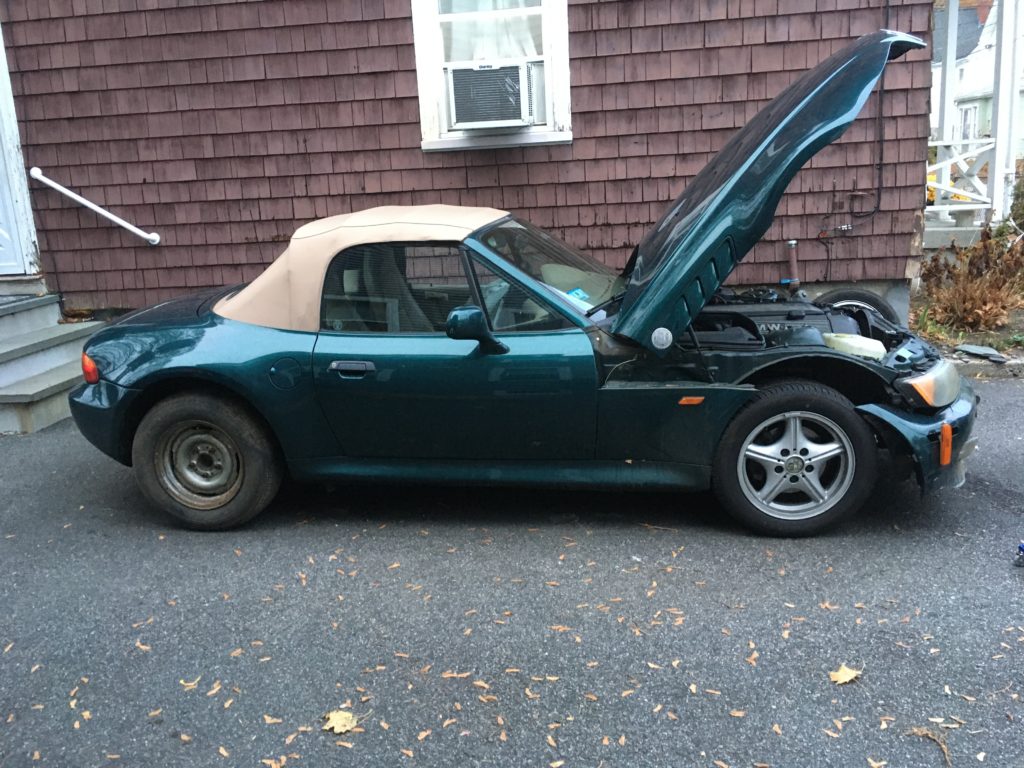
Bavaria wheels to the rescue!
With the car now sitting level, I centered the steering wheel. The left front wheel was pointing fairly straight, but the right front wheel looked like Marty Feldman’s right eye, pointing laughably far off to the side.
I jacked up the nose, set the car on stands, and had a quick look underneath. The first thing I saw was that the cast-aluminum bracket for the a/c compressor and idler pulley had been shattered, and the belt was AWOL. I then noticed that the lower part of the housing of the electric condenser fan had been sheared off, and the bottom of the condenser was bent. As I looked around, I saw a variety of electrical connectors to the fan and side-marker lights that were hanging, some sheared off. There was also a good deal of splintered plastic shrouding.
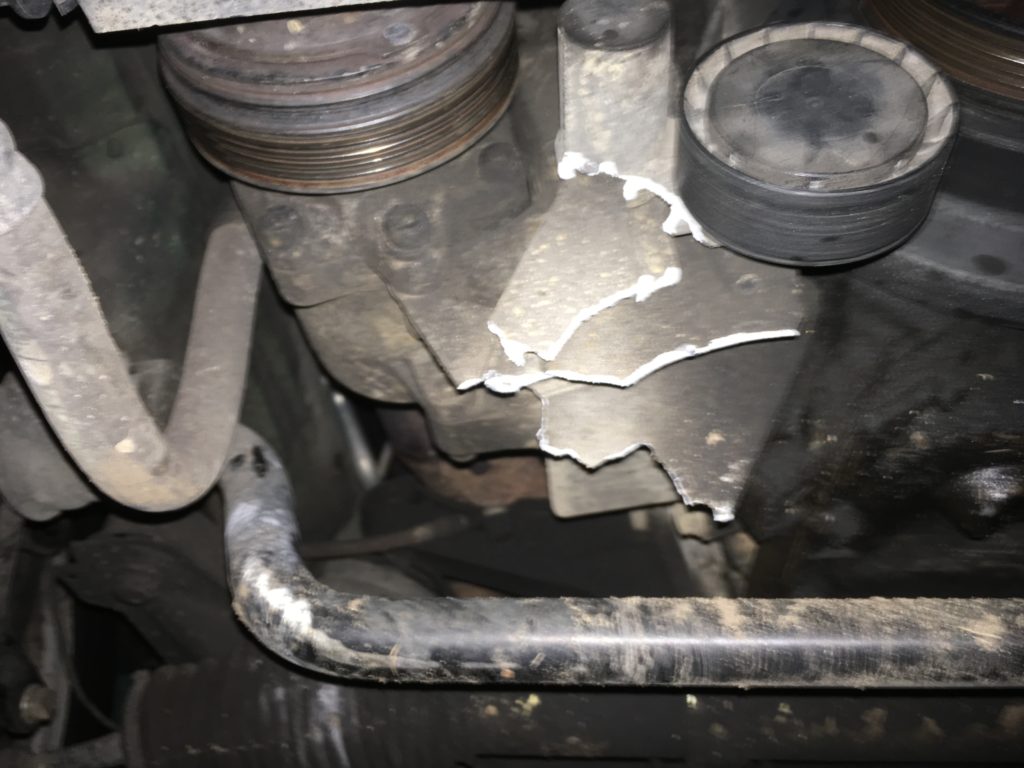
It hurts just looking at it, doesn’t it?
It took my eyes a while to zero in on the most important thing: the normally sickle-shaped right lower control arm was twisted out of its plane. No wonder the right front wheel was touching the back of the fender arch.
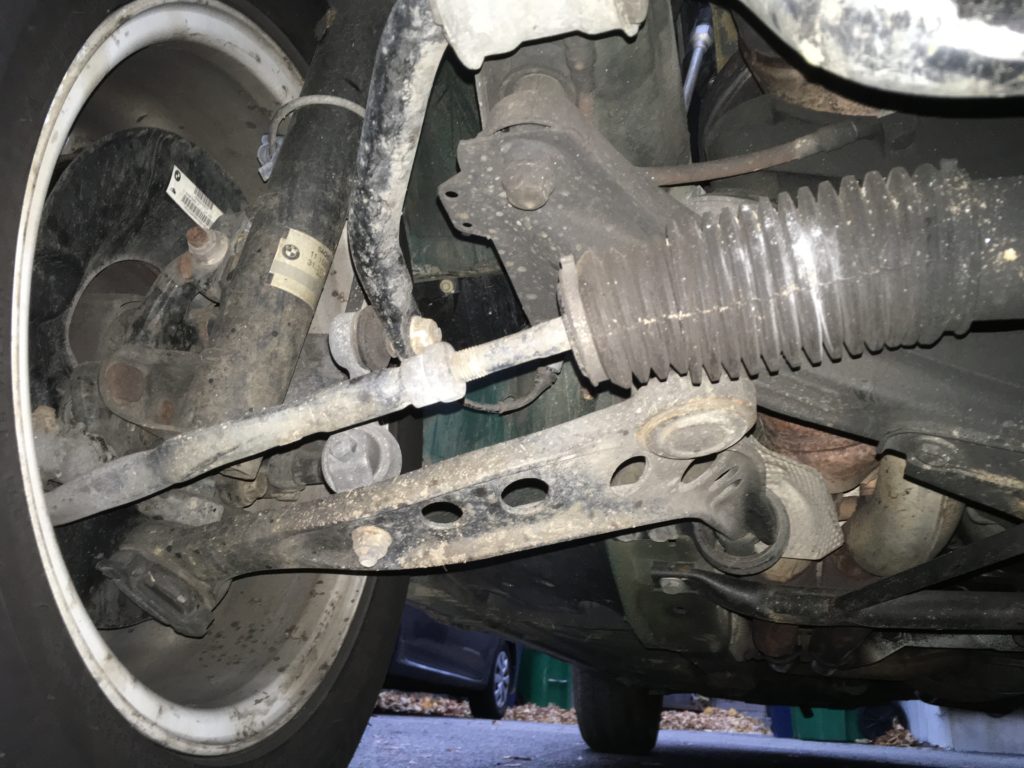
Well, THAT explains a lot.
It was all making more sense. The car had hit a median strip—a curb, really—something so low that it had missed the sheet metal, and incredibly, the movement of other things like the right front strut hadn’t torn up or bent the sheet metal, either, at least not that I’d seen.
I then looked at the top of the engine. Initially I saw nothing amiss—the radiator wasn’t pushed into the fan, for example—but then I noticed that two of the fan blades had broken off. I looked for other damage, but didn’t find any. I think it’s likely that this was a case of them breaking off from the deceleration of the impact. As they say, it’s not the fall that kills you, but the sudden stop.
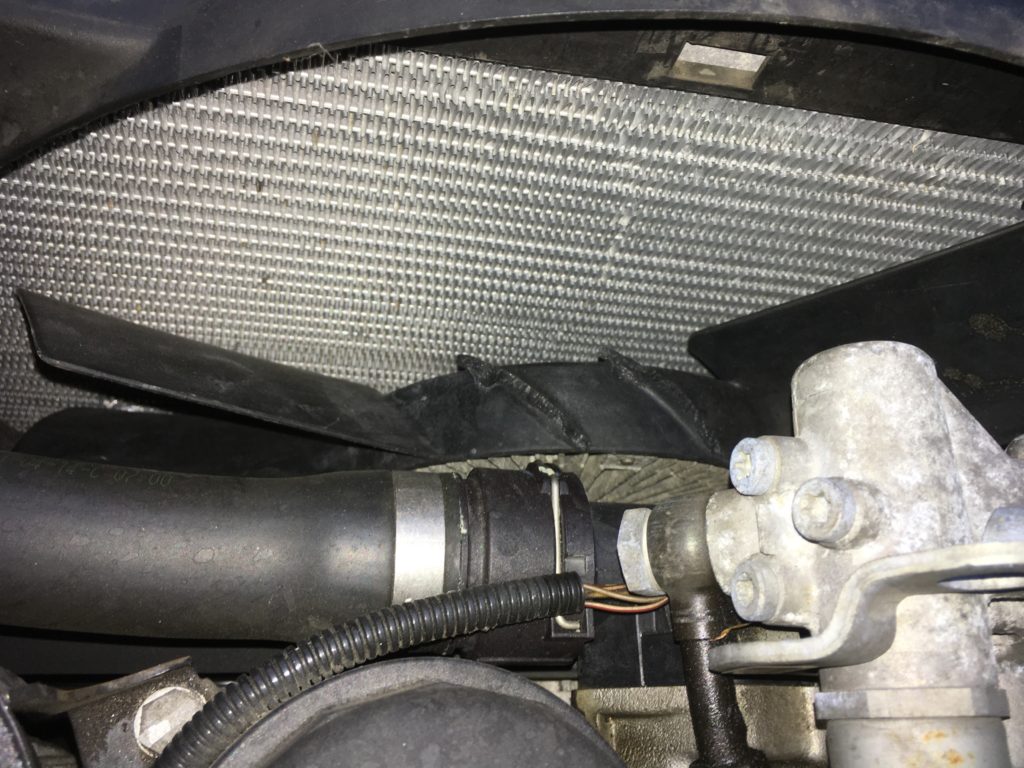
Odd but understandable.
I got in the car, made sure that the shift lever was in neutral, put my foot on the clutch, started the car, and was greeted by a chainsaw level of noise. I first thought it might be the fan, but it was just the noisy throw-out bearing, now worse than it was in August. I let it idle for a bit, got out of the car, looked beneath it, and saw no fluid streaming out. I shut it off, took it down off the jack stands, started it back up, and moved it a foot forward and backward in the driveway. As the junkyards say, “It runs and yard-drives.”
I then noticed that the right corner of the air dam, which I first thought was dangling, was instead just pushed on the other side of its attachment point. I grabbed it and carefully twisted it back into position. Suddenly, the car, which previously had looked like it’d had its face beaten senseless and had one eyeball hanging out of its socket, now looked more like it was emerging from a bad hangover.
Not bad for an hour’s work before sunset.
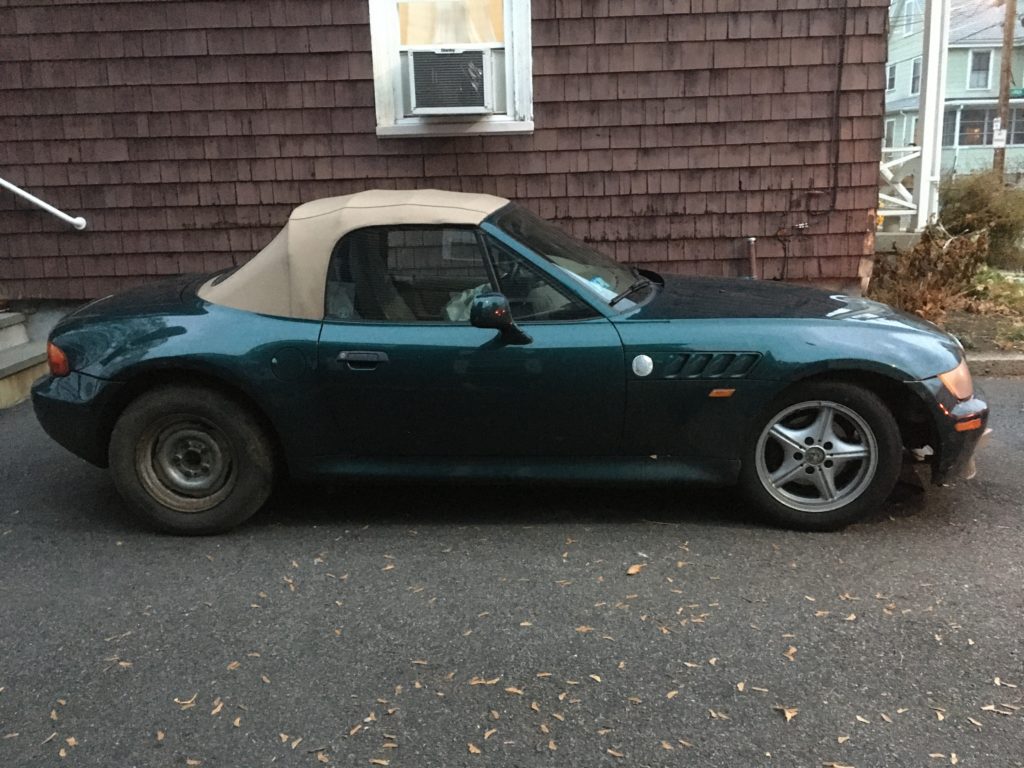
Ta-DA!
Well, then.
As of this writing, Kim and I are discussing Zelda’s fate. First things first: I need to get back over there and have a longer and more careful look at the car to see if there’s apparent subframe or unibody damage. We both agree that it would do our hearts good to see Zelda running again. Unfortunately, it’s the kind of thing where if I let my left brain drive, and add up the cost of lower control arms and other likely-needed suspension and steering components—wheels and possibly tires, air dam, fans, a/c components, plastic shrouding, lighting, plus the clutch that the car still needs—there’s zero upside in it for me.
However, the thought of someone parting out this car when it can likely be made drivable again makes me crazy.
I think it’s my fate to fix Zelda and keep karmic order in my corner of the universe, but right this moment I’ve got other projects backed up in the garage, and couldn’t get the car up on the lift, replace the lower control arms, yank the flaccid airbag out of the steering wheel, drive it, and see what happens, even if I wanted to—although you can tell that that’s kind of what I want to do, right? I think it’s likely just a question of mundane issues such as timing, garage space, and whether Kim continues to own the car, or sells it back to me.
As a writer, I’ve long been riveted by stories like this, where I actually have the power to change the way things end. Going the route of, “I got lazy and advised Kim to sell it for $1,000, and if the buyer parts it out, not my problem” makes for a bad ending. “Zelda, a car beloved by many, wasn’t hurt as bad as first feared, was fixed, and continues to bring joy” is a much more preferable coda.
I’ll let you know what happens.—Rob Siegel
Rob’s latest book, The Lotus Chronicles: One man’s sordid tale of passion and madness resurrecting a 40-year-dead Lotus Europa Twin Cam Special, is now available here on Amazon. Signed copies of this and his other books can be ordered directly from Rob here.

